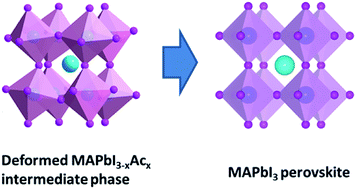Management of perovskite intermediates for highly efficient inverted planar heterojunction perovskite solar cells†
Abstract
Organic–inorganic hybrid lead halide perovskites (e.g., CH3NH3PbX3, X = Cl, Br, I) hold great promise in optoelectronic devices, e.g., solar cells. High-performance devices have been realized by controlling the perovskite surface morphology, grain size, and degree of crystallinity. However, the role of the components during film formation and crystallization remains mysterious. Here, we show the management of perovskite intermediates to construct perovskite films with uniform perovskite crystals and controlled surface morphology using methylammonium acetate (MAAc) to retard the reaction between PbI2 and MAI in the solution. The formation of MAPbI3 was allowed via the exchange of I− anions from the neighboring MAI molecules to the perovskite intermediate phases replacing Ac− anions. A highly efficient perovskite solar cell with a power conversion efficiency of 18.09% was achieved. The experimental and theoretical studies reveal that perovskite intermediates play an important role in facilitating homogeneous nucleation or modulating the crystallization kinetics. These results also provide important progress towards the understanding of perovskite intermediate phases for advancing the building of perovskite semiconductors.



 Please wait while we load your content...
Please wait while we load your content...